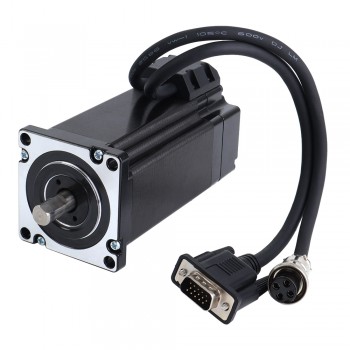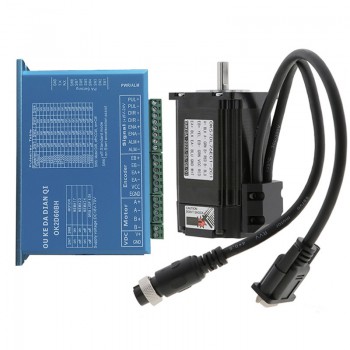1.Brief of a closed loop stepper motor
A closed-loop stepper motor system is a type of motor control that integrates an encoder feedback system with a standard stepper motor, enabling real-time position monitoring and adjustment to prevent step loss and improve accuracy, speed, and energy efficiency. This feedback allows the system to self-correct by continuously comparing the commanded position with the actual position, leading to a smoother, quieter operation with short settling times and higher torque, especially at low speeds, making it an attractive alternative to traditional open-loop steppers and even servo motors in many applications.

2.Main parts of a closed loop stepper motor
1.Stepper Motor:This is the core component that rotates in discrete steps. It includes a stator (the stationary part with coils) and a rotor (the rotating part with magnetic poles or teeth). In a closed-loop system, the motor’s rotor position is continuously monitored.
2.Encoder:This is the crucial feedback device that provides real-time information about the motor’s position and speed.
There are two main types:
Incremental encoders(Count pulses as the motor moves to determine relative position) and absolute encoders(Provide the exact position of the shaft at any given moment).
3.Motor Driver/Controller:This component receives commands from a higher-level controller or directly receives feedback from the encoder. It converts these signals into the correct electrical signals to drive the stepper motor. By comparing the commanded position with the position reported by the encoder, the driver can adjust the current to the motor to prevent lost steps, correct position errors, and optimize performance.
3.Methods for improving the accuracy of closed-loop stepper motors
1.Mechanical System Optimization:Minimize gaps in mechanical components like gears, lead screws, and couplings to prevent position errors, which can be done with high-precision, rigid mechanical systems.Use high-quality bearings and ensure proper alignment of components to create a more controlled motion path, leading to greater accuracy.
2.Motor and Feedback Selection:A motor with a smaller step angle provides finer angular displacement for a given number of pulses, improving resolution. Use an encoder with sufficient resolution and ensure it is placed at the actuator’s endpoint, not just the motor’s shaft, to get the most accurate position feedback.
3.Control System Enhancement:This is the core of a closed-loop system; the feedback device (like an encoder) provides real-time position data, allowing the controller to compare it with the command and make immediate adjustments to correct any errors.Divide each basic step into smaller microsteps to increase the motor’s resolution and smoothness, enabling more precise positioning.Implement sophisticated control algorithms that can dynamically adjust torque and compensate for factors like load variations, improving both position and velocity accuracy.
4.System Tuning and Maintenance:Regularly calibrate the motor and adjust parameters like current levels, acceleration/deceleration profiles, and microstepping settings to optimize performance.Identify and mitigate resonance frequencies that can cause vibrations and position errors by using notch filters in the motion controller.
5.Thermal Management:Stable Temperature: Keep the motor’s operating environment stable and ensure proper ventilation, heat sinks, or active cooling to prevent thermal-induced performance changes and accuracy issues.

4.Benefits of using closed-loop stepper motors
1.Enhanced Accuracy and Precision:Closed-loop stepper motors provide unmatched accuracy. The feedback system continuously monitors the motor’s position and corrects any deviations. This ensures precise movement, even in complex tasks. You can rely on these motors for applications requiring high precision, such as CNC machines or medical devices. The ability to maintain exact positioning reduces errors and improves overall performance.
2.Improved Reliability and No Step Loss:Step loss can disrupt operations and lead to costly errors. Closed-loop stepper motors eliminate this issue by using real-time feedback. The motor adjusts instantly to maintain its position, even under heavy loads. This reliability ensures smooth operation and reduces downtime.
3.High-Speed Performance and Torque Stability:Closed-loop stepper motors excel in high-speed applications. They maintain stable torque across a wide range of speeds. This makes them ideal for tasks requiring both speed and power. You can achieve faster production rates without sacrificing performance. The motor’s ability to handle varying loads ensures smooth and efficient operation.
4.Energy Efficiency and Reduced Power Usage:Energy efficiency is one of the key benefits of using closed-loop stepper motors. These motors adjust their power consumption based on the workload. This reduces energy usage and lowers operating costs. You can achieve significant savings while maintaining high performance. The efficient design also minimizes heat generation, extending the motor’s lifespan.
5.Adaptability to Dynamic Loads:Closed-loop stepper motors adapt quickly to changing conditions. The feedback system allows the motor to respond to dynamic loads in real time. This adaptability ensures consistent performance, even in demanding environments. You can use these motors in applications with variable workloads, knowing they will deliver reliable results.